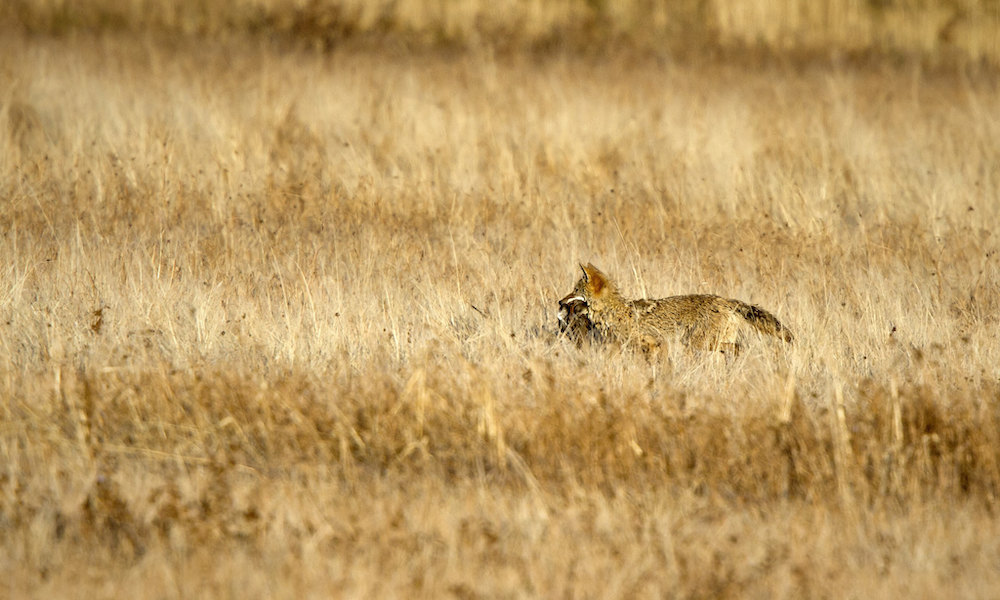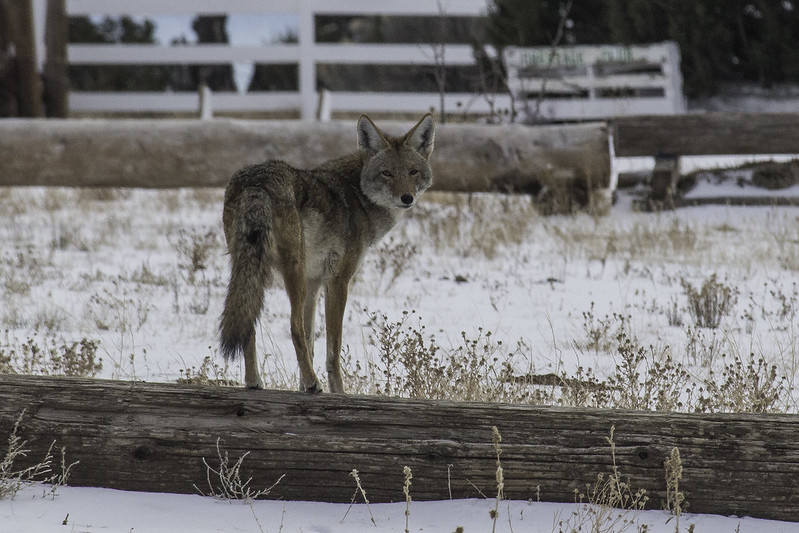
By Mariana Rivera Freeman, Field Science Specialist
Coyotes can be controversial. To different people and cultures, the coyote carries diverse significance. But outside of the meaning we give these animals, they have a natural purpose of their own. While they go about that purpose, they occasionally come into contact with us, whether in the wilderness, where coyotes prefer to spend their time, or in human spaces.
There are many reasons for coyotes to be moving through our neighborhoods. They cover a lot of miles in a single day, and human infrastructure interrupts wild spaces. There’s no harm in coyotes briefly crossing human corridors in order to get to the next canyon, forest, or creek, whether by day or night. The harm occurs when our behaviors encourage coyotes to linger.
Coyotes are omnivores and habitat generalists, and their ecological flexibility makes them particularly adept at taking advantage of what humans have to offer. Much of that has to do with the direct and indirect supplementation of food, one of the essential resources that indicate livable habitat for wildlife — others being water, space, and shelter. Coyotes inhabit spaces that provide the resources they need, and so to avoid encounters around our homes, we can start by not providing those resources. We can start by not feeding them.

There’s a model in wildlife ecology called optimal foraging theory, the simplified mathematics of which is energy gained subtracted by the energy spent to obtain it. Gained energy is simply calories. Spent energy includes the time and effort invested in searching, pursuing, handling, and eating calories. It is the coyote’s imperative to maximize the gain from this equation. It is our responsibility to disabuse the coyote of the idea that foraging optimization can be found in our neighborhoods. This means making it difficult, if not impossible, for coyotes to obtain human-supplemented energy.
When it comes to any human-supplemented food, much of what coyotes can find around our homes is plentiful and packed with calories. Calories can be found in trash cans, food left outside for pets or feral cats, rarely the pets themselves, more commonly the feral cats, bird seed and the rodents it attracts, poorly secured compost, edible litter — you get the idea. Search time for these calories is reduced (and therefore ideal) in human neighborhoods compared to the wild landscape around us. Pursuit, too, is abbreviated, as we are inadvertently staging the perfect traps for prey like small mammals and feral cats to be caught unawares. Handling and eating are generally quick and under the safety of darkness. In essence, by directly or indirectly feeding coyotes, we are optimizing their foraging.
We can’t let this happen if we want to avoid conflict with these clever animals. While the coyote is attempting to maximize the number on the other side of the equal sign (energy obtained – energy spent = net gain), it falls on us to minimize that number around our homes (energy obtained – energy spent = net loss). The more we ensure that number is a net loss, the less likely coyotes will linger in our neighborhoods for food.
A lingering coyote becomes a conflict. With all the wilderness space on the Pajarito Plateau, our coyote friends do not require supplemental food. They have resources aplenty, and habitat to meet their needs. Search, pursuit, handling, and eating is naturally more energy-expensive in wilderness, and this is as it should be; a predator’s natural difficulty in obtaining food is beneficial to the ecosystem. Keep food for the wild in the wild.
I mentioned pets as uncommon prey earlier. Though extremely rare, fatal encounters between dogs and coyotes do occur — one reported incident happened quite recently in Los Alamos. Coyotes can perceive domestic dogs as competition, or, when small enough, as potential prey. Culling coyotes doesn’t keep them away; barring an environmental or population catastrophe, coyotes will always be present on the Pajarito Plateau. In my next post, I’ll speak more on predator management, as well as what to do when you encounter a coyote, and how to proof your property against unwanted wildlife. In meantime, keep your trash secure, bring your birdseed in at night, and don’t feed your animals outside.
